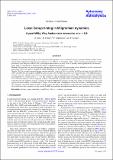Files in this item
Local Group timing in Milgromian dynamics : a past Milky Way-Andromeda encounter at z>0.8
Item metadata
| dc.contributor.author | Zhao, Hongsheng | |
| dc.contributor.author | Famaey, Benoit | |
| dc.contributor.author | Lüghausen, Fabian | |
| dc.contributor.author | Kroupa, Pavel | |
| dc.date.accessioned | 2014-01-14T12:31:07Z | |
| dc.date.available | 2014-01-14T12:31:07Z | |
| dc.date.issued | 2013-09 | |
| dc.identifier | 70763615 | |
| dc.identifier | 78b500ea-6c4e-4793-9e05-163a247f68c8 | |
| dc.identifier | 84882435158 | |
| dc.identifier.citation | Zhao , H , Famaey , B , Lüghausen , F & Kroupa , P 2013 , ' Local Group timing in Milgromian dynamics : a past Milky Way-Andromeda encounter at z >0.8 ' , Astronomy & Astrophysics , vol. 557 , L3 . https://doi.org/10.1051/0004-6361/201321879 | en |
| dc.identifier.issn | 0004-6361 | |
| dc.identifier.other | ArXiv: http://arxiv.org/abs/1306.6628v2 | |
| dc.identifier.uri | https://hdl.handle.net/10023/4365 | |
| dc.description.abstract | Context: Local Group (LG) timing is one of the first historical probes of the so-called missing mass problem. Whilst modern cosmological probes indicate that pure baryonic dynamics is not sufficient on the largest scales, nearby galaxies and small galaxy groups persistently obey Milgrom’s MOND law, which implies that dynamics at small scales is possibly entirely predicted by the baryons. Aims: Here, we investigate LG timing in this context of Milgromian dynamics. Methods: We used the latest measured proper motions and radial velocities for Andromeda and the Magellanic clouds, and we integrated their orbits backwards by making use of the Milgromian two-body equation of motion. Results: With the currently measured proper motions and radial velocity of M31, we find that MOND would imply that the Milky Way (MW) and M31 first moved apart via Hubble expansion after birth, but then necessarily were attracted again by the Milgromian gravitational attraction, and had a past fly-by encounter before coming to their present positions. This encounter would most probably have happened 7 to 11 Gyr ago (0.8 < z < 3). The absence of a dark matter halo and its associated dynamical friction is necessary for such a close encounter not to have triggered a merger. Observational arguments which could exclude or favour such a past encounter would thus be very important in order to falsify or vindicate Milgromian dynamics on the scale of the LG. Interestingly, the closest approach of the encounter is small enough (<55 kpc) to have had severe consequences on the disc dynamics, including perhaps thick disc formation, and on the satellite systems of both galaxies. The ages of the satellite galaxies and of the young halo globular clusters, all of which form the vast polar structure around the MW, are consistent with these objects having been born during this encounter. | |
| dc.format.extent | 4 | |
| dc.format.extent | 224362 | |
| dc.language.iso | eng | |
| dc.relation.ispartof | Astronomy & Astrophysics | en |
| dc.subject | Galaxies: groups: individual: Local Group | en |
| dc.subject | Galaxy evolution | en |
| dc.subject | Gravitation | en |
| dc.subject | QB Astronomy | en |
| dc.subject | QC Physics | en |
| dc.subject.lcc | QB | en |
| dc.subject.lcc | QC | en |
| dc.title | Local Group timing in Milgromian dynamics : a past Milky Way-Andromeda encounter at z>0.8 | en |
| dc.type | Journal article | en |
| dc.contributor.sponsor | Science & Technology Facilities Council | en |
| dc.contributor.institution | University of St Andrews. School of Physics and Astronomy | en |
| dc.identifier.doi | https://doi.org/10.1051/0004-6361/201321879 | |
| dc.description.status | Peer reviewed | en |
| dc.identifier.grantnumber | ST/J001651/1 | en |
This item appears in the following Collection(s)
Items in the St Andrews Research Repository are protected by copyright, with all rights reserved, unless otherwise indicated.

